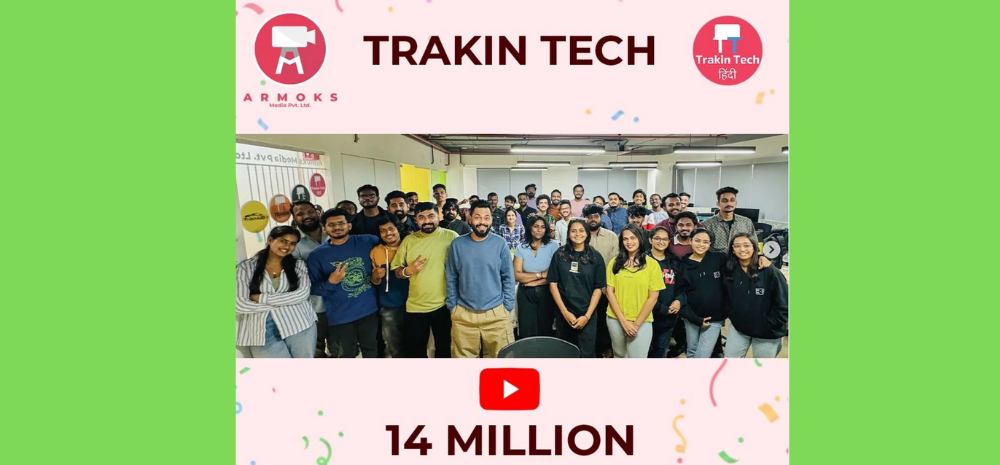Recently, we interacted with Mr. Giresh Kulkarni, Founder and CEO, Temple Connect – An Initiative to Connect the Global Pilgrim with the Various Temples and Shrines …Globally.
![[Exclusive Interview] This Startup Is Connecting Devotees With Temples By Leveraging The Power Of Technology](https://trak.in/stories/wp-content/uploads/2023/12/ify-14-2.png)
Here are the interview highlights:
What motivated you to focus on empowering temple tourism?
Certainly, I was inspired to focus on empowering temple tourism by recognizing the substantial efforts put into promoting tourism in India. While there has been commendable attention given to popular destinations like the Chardham yatra, Vaishnodevi Devi shrine, and the 12 jyotirlingas, there is a vast array of other significant temple locations that remain largely untapped.
Observing the limited promotion of these lesser-known but culturally rich temples, I identified a gap in the management experience, convenience, and end-to-end service provision in the temple pilgrimage and devotee experience sector. It became evident that there is a need for comprehensive support and promotion for these overlooked destinations.
Embracing the philosophy of Mahatma Gandhi, who encouraged being the change one wishes to see in the world, I felt a personal responsibility to contribute to the enhancement of temple tourism. Why wait for someone else to empower it when I could take the initiative and make a positive impact myself? With a genuine interest in visiting temples and a passion for improving the overall experience for devotees, I saw an opportunity to make a meaningful difference in this space. I believe that by empowering temple tourism, we not only contribute to the cultural richness of our nation but also create a more fulfilling and convenient experience for those seeking spiritual journeys.
How did the idea for your innovative start-up originate?
My journey into the realm of an innovative start-up originated from a unique intersection of my background in media, communication events, and digital media, coupled with a deep-seated passion for temples and temple trotting. Having explored over 4000 temples across 50 countries, my interest in these sacred places was not only a personal pursuit but a realisation that there was an untapped opportunity to blend my professional expertise with my fervour for temple exploration.
The idea for my innovative start-up emerged as I recognized the potential to bridge the gap between my diverse professional background and my passion for temples. I understood that the knowledge, studies, and experiences accumulated throughout my career could be seamlessly incorporated into the world of temple tourism. This realisation marked the inception of my journey to create a platform that not only showcases the cultural and spiritual significance of temples but also leverages my expertise in media and digital communication to enhance the overall temple-trotting experience.
In essence, the idea of my start-up lies in the convergence of my diverse skill set and unwavering passion, transforming a personal interest into a venture that strives to make a meaningful impact in the intersection of media and temple exploration
Could you elaborate on the concept of ‘Temple Trotter’ and explain how the Smart Temple Mission contributes to the overall management and administration of temple opening events? Also, tell us more about your different missions at Temple Connect
The concept of ‘Temple Trotter’ is rooted in the dynamic movement and exploration of temples, resembling the lively hopping of bugs from one place to another. For me, it involves not just physically visiting these sacred places but delving deep into the essence of each temple, gathering a wealth of information encompassing its history, rituals, culture, local culinary offerings, accommodation options, and recommended activities.
Now, transitioning to the Smart Temple Mission, our primary goal is to revolutionise the gap between devotees and their pilgrimage experiences through technological convenience. It’s a unique and ambitious initiative aimed at modernising temples, with a key focus on implementing a “Devotee-Centric Approach for Convenience.” This shared mission goes beyond merely enhancing temple and pilgrim tourism; it also plays a pivotal role in fostering the growth of temple-dependent economies.
When it comes to the management and administration of temple opening events, the Smart Temples Mission leverages technology to create a seamless and convenient experience for devotees throughout their spiritual journeys. By integrating innovative solutions into the temple experience, we ensure that devotees can navigate sacred spaces with unprecedented ease, thus deepening their connection with spirituality.
As for our different missions at Temple Connect, each mission is tailored to address specific aspects of temple management and devotee experience. For instance, we have missions focused on cultural preservation, educational outreach, and community engagement. These diverse missions collectively contribute to our overarching goal of making temple visits more enriching, accessible, and spiritually fulfilling for individuals from all walks of life.
Considering your start-up’s emphasis on crowd management, what suggestions do you have for regulating entry and exit points during the opening of the Ram Mandir to control the crowd?
When we talk about handling a massive crowd, being organised and disciplined is supremely important. Especially when we’re dealing with something as big as the opening of the Ayodhya Ram Mandir. The Pran Pratishta stapana is happening as well as the lokarpan of the temple is scheduled. First things first, it’s crucial for people to know that from the 22nd to the 24th, during the temple launch, it’s not the ideal time for a regular visit. Even though we’re saying it’s better to avoid going then, if you do decide to go, make sure you park your vehicle in a way that doesn’t bother others.
To make sure people get in and out smoothly, we’re suggesting a systematic line system. You should get the right tickets or passes from the temple organisers. We’ve set up organised lines at the Ram Mandir to keep things in order. Also, if you’re going with kids or elderly people, be careful. Give them the right info and keep important phone numbers handy in case they get seperate or something happens. Being careful like this is important for everyone’s safety. Lastly, we’re thinking about letting people in at different times instead of all at once. This way, we can avoid huge crowds and make managing everything a lot easier. It’s about finding a good balance so that everyone can enjoy the experience without too much chaos, especially during peak times.
How does your virtual platform offering poojan, karma kanda, and related services impact traditional practices performed by physical presence, potentially affecting employment opportunities for pandits and favouring those with tech proficiency?
Temple Connect doesn’t do the usual puja or karmakand services. We noticed that many people and groups are already doing a great job with these services, doing it well and with authenticity. What we do at Temple Connect is showcase and support the online services provided by temple managements, pujaris, and archakas from different temples. We want to make it easier for people to find them by sharing their contact info and services. Our goal is to help without repeating what others are already doing well and keeping the traditional practices genuine.
Using technology, Temple Connect wants to make these services available to more people. Our virtual platform doesn’t replace the traditional way of doing things in person; it just adds to it by reaching more people online. We aim to boost visibility, connect these service providers with a bigger audience, and make sure people get top-quality traditional services. It’s crucial for us to find a balance. We want to keep the traditional practices real and true while using technology to make them more accessible. Our goal is not to take away jobs from pandits and traditional practitioners but to use tech skills to help them reach more people without changing the heart of what they do. It’s about working together for the benefit of everyone involved.
Regarding the surge in religious expression among today’s youth on social media, what are your thoughts on this phenomenon?
Temple Connect has been working closely with people from all around the world, promoting devotion, sharing content, and connecting with a larger audience. It’s surprising, but a lot of our audience, especially those between 21 to 32 years old, are keenly exploring information about temple devotion, spirituality, and the experiences related to visiting temples. The numbers have been going up, and it’s great to see more awareness and interest in rituals, devotion, the history of gods and goddesses, and important temple places.
What’s really important to us is making all this information easily available to people. We believe that every temple should set aside a certain percentage of their collections to promote their temple, the religion, or the sentiments followed there. In the past, there were Ved Patshalas where students from every household would go to learn. While this practice has become less common nowadays, we think every temple can do something similar to what ISKCON does with distributing Shrimad Bhagavad Gita to educate people about the beliefs behind it. Each temple can have something related to their god, goddess, or deity to share knowledge and connect with more people. I believe every temple, big or small, should focus on this activity.
Now, talking about the surge in religious expression among today’s youth on social media, I see it as a positive phenomenon. It’s heartening to witness young people expressing their interest and curiosity about spirituality, rituals, and the cultural aspects of their faith on platforms like social media. It indicates a growing awareness and a desire to explore and understand their roots and traditions. Embracing technology and social media allows for a broader reach and facilitates an easy interface with the masses, making religious knowledge and experiences more accessible to the younger generation. This trend aligns with Temple Connects mission of promoting devotion and connecting people with the rich cultural and spiritual heritage associated with temples.
As a creator, podcaster, social entrepreneur, and proud Hindu, how do you define being a proud Hindu in the current scenario?
As a proud Hindu, I believe it’s essential for all of us, regardless of our birthplace or beliefs, to recognize that Hinduism is more than just a religion; it’s a way of life. What’s crucial is spreading awareness about our culture to the world and ensuring that we ourselves understand and practise it sincerely.
One way to do this is by making a commitment to visit at least one new temple every month. It’s not just about our personal beliefs but also about exploring new temples, supporting their local economies, and contributing in ways beyond just spending money. This includes initiatives like Annadan (food distribution), distributing warm clothes, and engaging in various activities that benefit the temple and the community it serves.
Taking up responsibilities and delivering on them is another crucial aspect. By setting personal disciplines, like empowering the temple ecosystem and promoting Hinduism through book distribution, we can actively contribute to the community.
In the current scenario, being a proud Hindu means not just practising our faith privately but also sharing it with others. It involves taking on responsibilities, delivering on them, and encouraging others to join in with a shared vision and mission. Whether it’s visiting twelve different temples in a year, capturing and promoting those experiences, or connecting with new places across the country and the world, the goal is to energise and spread the richness of our culture through meaningful actions and shared content.
Every journey teaches us and brings a change in us. So what do you learn from your exciting journey?
Through this journey, the most important thing I’ve learned is that there’s a big need for awareness and improvement in the temple management space. I’ve seen that people are open to new ideas and thoughts, and there’s a significant demand for making temples more accessible and beneficial for the common man.There are two sides to temple management. One is the B to B side, where institutions work with each other to improve and offer services to the common man, who, in the end, is the devotee supporting the temple through donations and transactions.
The other side is about the devotee’s experience – their expectations, stay, hospitality, and travel. This area has been quite unorganised in the organised sector. Temple Connect, through initiatives like Temple Connects Smart Temples Mission, and the Indian Puja Company, is working hard to empower and grow this sector both domestically and internationally. A key lesson I’ve taken is the importance of creating products or services that I would use myself. It’s crucial to offer something that you believe in and would find comfortable using. This way, the whole ecosystem gets stronger, and people benefit in the long run through a continuous process of improvement and empowerment.










